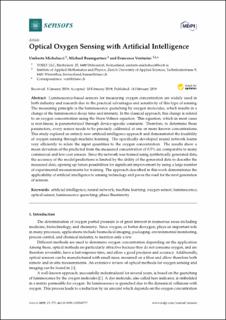Please use this identifier to cite or link to this item:
https://doi.org/10.21256/zhaw-5031| Publication type: | Article in scientific journal |
| Type of review: | Peer review (publication) |
| Title: | Optical oxygen sensing with artificial intelligence |
| Authors: | Michelucci, Umberto Baumgartner, Michael Venturini, Francesca |
| DOI: | 10.21256/zhaw-5031 10.3390/s19040777 |
| Published in: | Sensors |
| Volume(Issue): | 19 |
| Issue: | 4 |
| Page(s): | 777 |
| Issue Date: | 2019 |
| Publisher / Ed. Institution: | MDPI |
| ISSN: | 1424-8220 1424-8239 |
| Language: | English |
| Subjects: | Artificial intelligence; Luminescence; Luminescence quenching; Machine learning; Neural network; Optical sensor; Oxygen sensor; Phase fluorimetry |
| Subject (DDC): | 006: Special computer methods |
| Abstract: | Luminescence-based sensors for measuring oxygen concentration are widely used in both industry and research due to the practical advantages and sensitivity of this type of sensing. The measuring principle is the luminescence quenching by oxygen molecules, which results in a change of the luminescence decay time and intensity. In the classical approach, this change is related to an oxygen concentration using the Stern-Volmer equation. This equation, which in most cases is non-linear, is parameterized through device-specific constants. Therefore, to determine these parameters, every sensor needs to be precisely calibrated at one or more known concentrations. This study explored an entirely new artificial intelligence approach and demonstrated the feasibility of oxygen sensing through machine learning. The specifically developed neural network learns very efficiently to relate the input quantities to the oxygen concentration. The results show a mean deviation of the predicted from the measured concentration of 0.5% air, comparable to many commercial and low-cost sensors. Since the network was trained using synthetically generated data, the accuracy of the model predictions is limited by the ability of the generated data to describe the measured data, opening up future possibilities for significant improvement by using a large number of experimental measurements for training. The approach described in this work demonstrates the applicability of artificial intelligence to sensing technology and paves the road for the next generation of sensors. |
| URI: | https://digitalcollection.zhaw.ch/handle/11475/15524 |
| Fulltext version: | Published version |
| License (according to publishing contract): | CC BY 4.0: Attribution 4.0 International |
| Departement: | School of Engineering |
| Organisational Unit: | Institute of Applied Mathematics and Physics (IAMP) |
| Appears in collections: | Publikationen School of Engineering |
Files in This Item:
| File | Description | Size | Format | |
|---|---|---|---|---|
| 2019_Michelucci_Optical_oxygen_sensing_with_artificial_intelligence.pdf | 1.9 MB | Adobe PDF |  View/Open |
Show full item record
Michelucci, U., Baumgartner, M., & Venturini, F. (2019). Optical oxygen sensing with artificial intelligence. Sensors, 19(4), 777. https://doi.org/10.21256/zhaw-5031
Michelucci, U., Baumgartner, M. and Venturini, F. (2019) ‘Optical oxygen sensing with artificial intelligence’, Sensors, 19(4), p. 777. Available at: https://doi.org/10.21256/zhaw-5031.
U. Michelucci, M. Baumgartner, and F. Venturini, “Optical oxygen sensing with artificial intelligence,” Sensors, vol. 19, no. 4, p. 777, 2019, doi: 10.21256/zhaw-5031.
MICHELUCCI, Umberto, Michael BAUMGARTNER und Francesca VENTURINI, 2019. Optical oxygen sensing with artificial intelligence. Sensors. 2019. Bd. 19, Nr. 4, S. 777. DOI 10.21256/zhaw-5031
Michelucci, Umberto, Michael Baumgartner, and Francesca Venturini. 2019. “Optical Oxygen Sensing with Artificial Intelligence.” Sensors 19 (4): 777. https://doi.org/10.21256/zhaw-5031.
Michelucci, Umberto, et al. “Optical Oxygen Sensing with Artificial Intelligence.” Sensors, vol. 19, no. 4, 2019, p. 777, https://doi.org/10.21256/zhaw-5031.
Items in DSpace are protected by copyright, with all rights reserved, unless otherwise indicated.